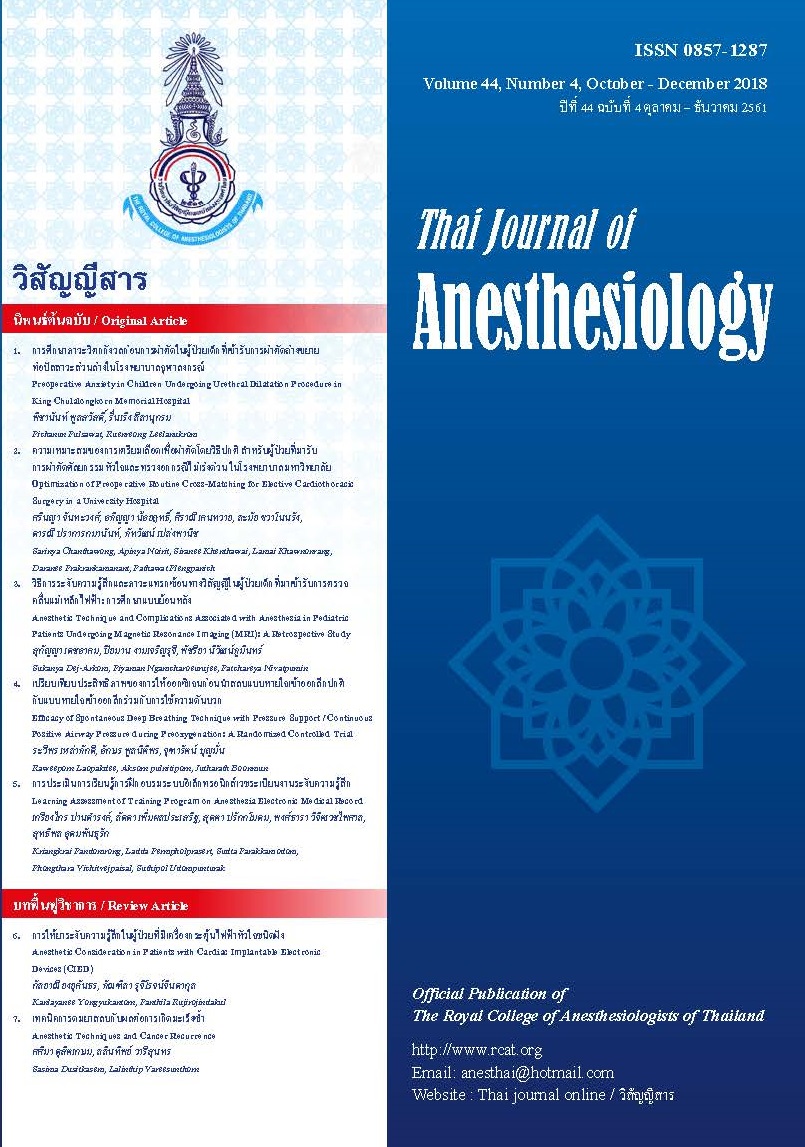Anesthetic Technique and Complications Associated with Anesthesia in Pediatric Patients Undergoing Magnetic Resonance Imaging (MRI): A Retrospective Study
Main Article Content
Abstract
Background: Patients’ co-operation or immobilization is required in Magnetic Resonance Imaging (MRI) procedure. Different techniques of anesthesia assist pediatric patients in controlling their movement. Our objective was to retrospective review and report anesthetic techniques used as well as incidence of complications associated with anesthesia.
Methods: Data of 383 pediatric patients aged between 0-6 years in from May 2012 to December 2013 in Siriraj Hospital were retrospectively chart review. The demographic characteristics, diagnosis, anesthetic techniques, duration of the procedure and complications were collected and analyzed in descriptive statistic.
Results: During the study period, there were 383 patients receiving MRI procedure under caring by anesthesiologists, excluded cardiac MRI. The majority of patients was in age group of 0-12 months (41.8%) and classified as ASA classification of 1-2 (93.2%). The main anesthetic of choice was intravenous sedation with inhalation insufflation (53.3%). The first and second most common complications were bradycardia and hypotension accounting for 1.2% and 0.8% respectively.
Conclusion: The most popular anesthetic technique used in MRI procedure in Siriraj Hospital was intravenous sedation with inhalation insufflation. Although the low incidence of adverse effects was shown, anesthetic personnel should be aware of any complication that may occur in anesthesia of pediatric patients undergoing MRI procedure.
Article Details
References
2. Wachtel RE, Dexter F, Dow AJ. Growth rates in pediatric diagnostic imaging and sedation. Anesth Analg 2009; 108(5):1616-21.
3. Waikakul W, Pongwattanasuk T, Puangpanya W, et al. Mortality and morbidity in pediatric patients underwent MRI and CT under general anesthesia. Thai J Anesthesiology 2014;40(4):283-93.
4. Amornyotin S, Phomthong P, Reunreung W. Anesthesia for nuclear medicine procedures in children from 2002-2004 in Siriraj hospital: a retrospective study. Thai J Anesthesiology 2006;32(3):182-90.
5. Jirativanont T, Manomayangkul K, Udomphorn Y, et al. Incidence and risk factors for adverse events during anesthesiologist-led sedation or anesthesia for diagnostic imaging in children: a prospective, observational cohort study. Asian Biomedicine 2015;9(5):649-58.
6. Malviya S. Sedation and general anaesthesia in children undergoing MRI and CT: adverse events and outcomes. Br J Anaesth 2000;84:743-8
7. Sury MR, Harker H, Thomas ML. Sevoflurane sedation in infants undergoing MRI: a preliminary report. Paediatr Anaesth 2005;15(1):16-22.
8. Cortellazzi P, Lamperti M, Minati L, et al. Sedation of neurologically impaired children undergoing MRI: a sequential approach. Paediatr Anaesth 2007; 17:630-36.
9. Dalal P, Murray D, Cox T, et al. Sedation and anesthesia protocols used for magnetic resonance imaging studies in infants: provider and pharmacologic considerations. Anesth Analg 2006; 103:863-68.
10. Mason K, Zurakowski D, Zgleszewski S, et al. High dose dexmedetomidine as the sole sedative for pediatric MRI. Paediatr Anaesth 2008; 18:403-11.
11. Sanborn PA, Michna E, Zurakowski D, et al. Adverse cardiovascular and respiratory events during sedation of pediatric patients for imaging examinations. Radiology 2005;237(1):288-94.

